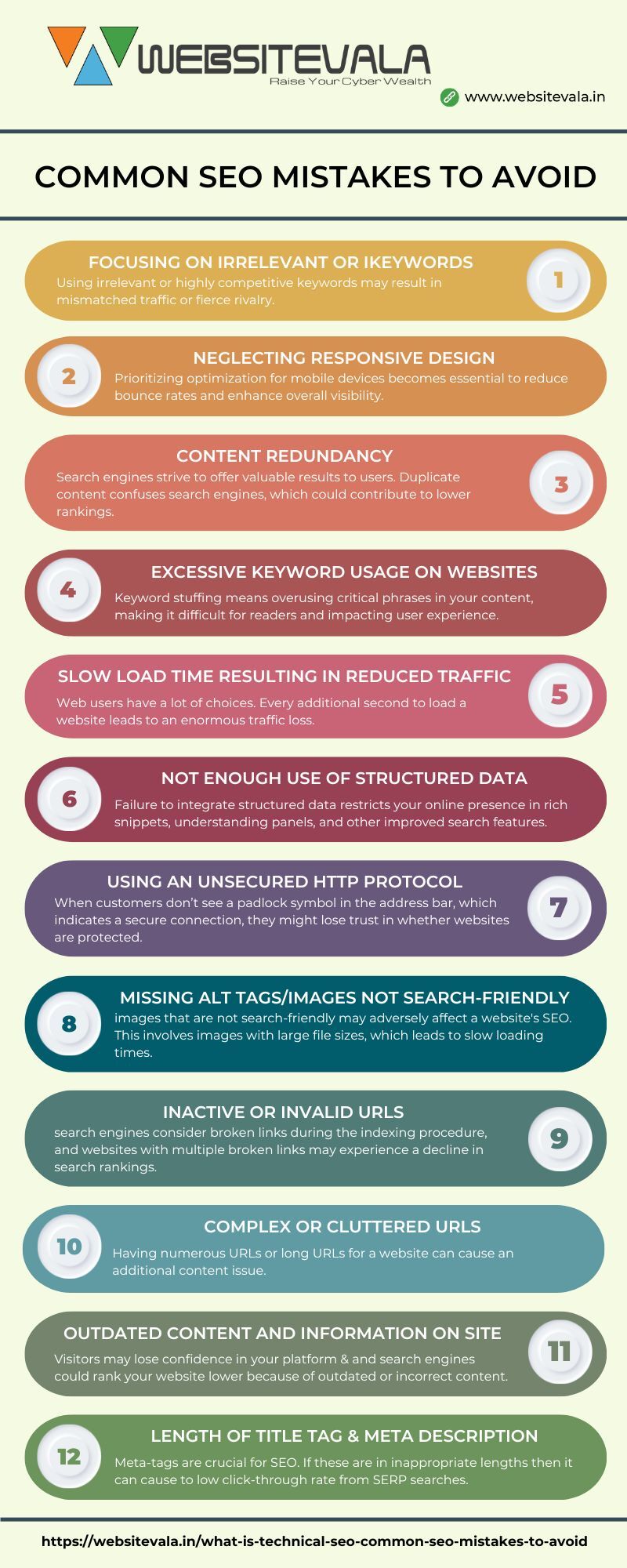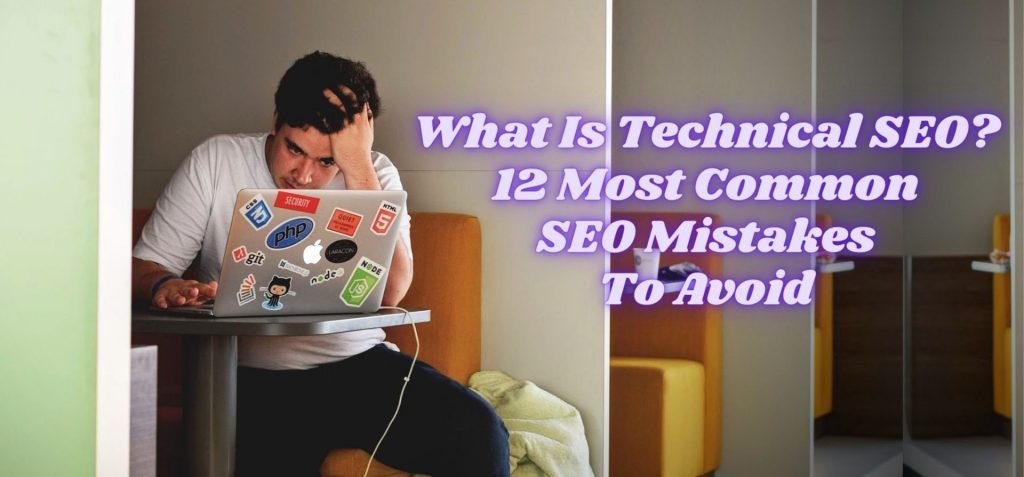Jump Directly to the Topic of Your Interest
Toggle- What is technical SEO?
- How do SEO issues affect your website?
- Why is it important to check for SEO issues?
- 12 Most Common SEO mistakes to avoid
- 1. Focusing on irrelevant or inappropriate keywords
- 2. Neglecting responsive design
- 3. Content redundancy
- 4. Slow load time resulting in reduced website traffic
- 5. Excessive Keyword Usage on Websites
- 8. Using an unsecured HTTP protocol
- 7. Not Enough Use of Structured Data
- 8. Missing Alt Tags/Images That Are Not Search-Friendly
- 9. Inactive or invalid URLs
- 10. Outdated Content and Information on Site
- 11. Complex or Cluttered URLs
- 12. Inappropriate Length of Title Tag & Meta Description
- Final thoughts
The development of automated SEO tools has transformed website optimisation, making it progressively user-friendly. But with the ever-changing digital marketing world, there are a lot of possible risks hiding beneath the surface of your website.
Unaddressed, these mistakes can hinder the overall performance of your digital presence. In this dynamic environment, comprehending and carrying out technical SEO becomes essential.
Technical SEO is making the most of your website’s components and infrastructure to increase search engine efficiency and visibility. By following this procedure, search engines are guaranteed to be able to effectively crawl, index, and rank your website.
In this blog, we will look into what is technical SEO and why is it important? and examine the Common SEO mistakes to avoid which can prevent any website owner from traversing the intricate details of the digital landscape.
What is technical SEO?
Technical SEO is a general term that includes any technical procedure that improves the organic search visibility of your website. Technical SEO does not include data analysis, keyword research, backlink profile development, or social networking tactics.
It concentrates less on keyword integration and more on technical characteristics, like fast loading time and a secure server, to guarantee that scanning bots can comprehend your website’s information.
Technical SEO is one of the effective strategies to ensure your website gets the attention it deserves.
How do SEO issues affect your website?
Understanding the technical aspects of your website and how they may impact its functionality and search engine rankings is crucial if you own a website. The process of optimizing your website for search engines to index and crawl is known as technical SEO.
It includes site speed, mobile optimisation, HTML structure, sitemaps, and URLs. Technical SEO, when done right, can improve your site’s user experience, traffic, and visibility.
Outdated content can affect SEO by reducing relevance, resulting in lower search rankings. Duplicate content creates problems for search engines, potentially leading to penalization and decreased visibility for your website. Analysing these problems is important for having a strong online presence.
Moreover, the responsiveness of mobile devices is becoming more and more important. Smartphone-friendly websites are given preference by search engines. If the website is optimised for mobile devices, it could result in higher search engine rankings.
These problems might hinder your site from ranking high in search engine results pages (SERPs) and drive visitors to your competitors’ sites. To increase your site’s SEO performance, you must identify and address these problems.
Why is it important to check for SEO issues?
SEO analysis is a crucial part of any online marketing plan. You can gain important insights that will improve your online presence by analyzing the effectiveness of your website and comprehending how it appears in search engine results.
SEO analysis assists in recognising high-performing keywords, enabling you to optimize your content and draw in more organic traffic. When you check for SEO issues, you’re carrying out a health check for your website from the perspective of search engines.
For example, search engines consider elements like relevant keywords, high-quality content, and user-friendly design when ranking content. If your website has broken links or needs some components that are not available, it might perform poorly in search engine results.
By frequently performing SEO analysis, you can stay ahead of the competition, enhance your search visibility and eventually bring more traffic and conversions to your website.
12 Most Common SEO mistakes to avoid
As the development of automated SEO tools continues to revolutionize website optimization, it’s easy to overlook the potential risks that lurk beneath the surface of your website. However, unaddressed mistakes can significantly hinder your digital presence. Explore these 12 common SEO mistakes to avoid, ensuring that your website remains visible and competitive in the ever-changing landscape of digital marketing.
1. Focusing on irrelevant or inappropriate keywords
Precision in choosing keywords is essential. Using irrelevant or highly competitive keywords may result in mismatched traffic or fierce rivalry. Perform thorough keyword research, consider your audience’s search intent, and prioritise terms that align with your content.
2. Neglecting responsive design

As the mobile user demographic continues to play an important part in web traffic, prioritizing optimization for mobile devices becomes essential to reduce greater bounce rates and enhance overall visibility. To successfully interact with this growing audience, use responsive design, enhance page load time, and foster a smooth mobile browsing experience.
3. Content redundancy
Search engines strive to offer valuable results to users. Duplicate content confuses search engines, which could contribute to lower rankings. Regularly audit your site for duplicate content and employ canonical tags or redirects to gather similar pages, enhancing your site’s SEO health.
4. Slow load time resulting in reduced website traffic

Web users have a lot of choices. Every additional second to load a website leads to an enormous traffic loss. A good page load speed enhances on-page SEO, consumer satisfaction, and website ranking and reduces operational costs.
You can utilise the Google PageSpeed Insights tool to get information related to your page speed. It will demonstrate the efficiency of your page, related data and loading time for mobile and desktop computers. It offers additional suggestions on how the efficiency of that page may be enhanced.
5. Excessive Keyword Usage on Websites
While keywords are crucial for SEO, using them can help your rankings. Keyword stuffing means overusing critical phrases in your content, making it difficult for readers and impacting user experience. Instead, concentrate on using keywords carefully and simply within your content. Perform keyword research and adjust the content and metadata of your website appropriately.
8. Using an unsecured HTTP protocol

One of the most prevalent issues with websites is related to HTTP status or server issues, like 4xx errors.
HTTPS is essential for establishing credibility with users. When customers see a padlock symbol in the address bar, it indicates a secure connection, ensuring that their communications with the website are protected.
Trust is essential for online companies and platforms, affecting user engagement, conversions, and overall performance.
7. Not Enough Use of Structured Data
Structured data, expressed through schema markup, provides search engines with an enhanced understanding of your content. Failure to integrate structured data restricts your online presence in rich snippets, understanding panels, and other improved search features.
Implement schema markup that matches your content, improving its visibility while offering users more informative search results. For instance, if you have a recipe page, schema markup can include information about cooking time, ingredients, and ratings.
This additional information not only improves the search engine’s understanding of your content but also increases the visibility and appeal of your results to users, offering more detailed and informative snippets in search listings.
8. Missing Alt Tags/Images That Are Not Search-Friendly

Alt tags, or alternative text, act an essential function in web development, especially in search engine optimization (SEO) and web accessibility. These descriptive features for images on a website serve as vital for search engines, offering crucial context and relevance to photos.
Search engines rely on alt tags to understand and rank content precisely, enhancing the connection between images and the overall context of a page.
In addition, alt tags are instrumental in improving web accessibility, as they help individuals with visual impairments who employ screen readers.
Moreover, images that are not search-friendly may adversely affect a website’s SEO. This involves images with large file sizes, which leads to slow loading times.
Search engines believe that page speed is an important ranking factor, and a slow-loading site can result in lower search rankings. Optimising images for search involves reducing file sizes, using suitable file formats, and organising image URLs with appropriate keywords.
9. Inactive or invalid URLs
Broken links, called dead-end links, pose an essential threat to user experience and search engine rankings. When users face broken links on a site, it can interfere with their browsing experience, resulting in frustration and an unfavourable impression of the site’s dependability.
In addition, search engines consider broken links during the indexing procedure, and websites with multiple broken links may experience a decline in search rankings. To tackle this issue, web admins can use different online tools, which systematically examine the site for broken links while offering an in-depth report.
This allows website administrators to recognise and correct dead-end links promptly, guaranteeing users an effortless experience and a positive standing in search engine rankings.
As part of a robust website maintenance strategy, frequently reviewing and correcting broken links is essential for sustaining an intuitive user experience and safeguarding search engine visibility.
10. Outdated Content and Information on Site
The website’s outdated information and content can adversely impact its current relevance and user satisfaction. Visitors may lose confidence in your platform, and search engines could rank your website lower because of outdated or incorrect content.
Regularly review and update the content to ensure it remains current, illustrating your commitment to offering valuable and precise information to users. This not only improves user satisfaction but also helps to improve search engine rankings.
11. Complex or Cluttered URLs
The URL structure of a web page can make an immense impact when it comes to SEO. It’s essential to utilise URLs that are search engine friendly.
Having numerous URLs or long URLs for a website can cause an additional content issue. It’s one of the on-page SEO errors you might be making.
12. Inappropriate Length of Title Tag & Meta Description

Enhancing the title of your content assists with search engine optimisation and can make the content rank in upper positions.
You have to maximise page titles for SEO since both users and search engines can determine your content based on the heading of a website.
Meta-tags are crucial for search engine optimisation. It can be used to enhance your click-through rate from SERP searches.
That includes relevant keywords and phrases in your meta descriptions will ensure that your page appears more frequently in search engine results.
Final thoughts
In conclusion, avoiding these 12 common SEO mistakes is crucial for maintaining and improving your website’s search engine rankings and overall performance.
By focusing on relevant keywords, implementing responsive design, addressing content redundancy, and optimizing page load times, you can enhance user experience and increase visibility in search engine results.
Additionally, prioritizing HTTPS protocol, structured data markup, and alt tags for images can further improve your website’s SEO health.
Regularly auditing your site for broken links, outdated content, and complex URLs, while ensuring appropriate length title tags and meta descriptions, will contribute to a robust SEO strategy.
By staying informed about the latest SEO trends and algorithm updates, you can effectively address technical issues and drive more organic traffic and conversions to your website.
Remember, avoiding these common SEO mistakes is key to achieving long-term success in the ever-evolving digital landscape.


MohammedTahir Patel is a Website Developer and Digital Marketing Consultant with 8+ years of experience in SEO, Local SEO, and online growth strategies. He specializes in building SEO-friendly WordPress websites, managing digital marketing campaigns, and helping small businesses grow their online presence. Passionate about technology and automation, MohammedTahir combines creativity with technical expertise to deliver results that matter.




